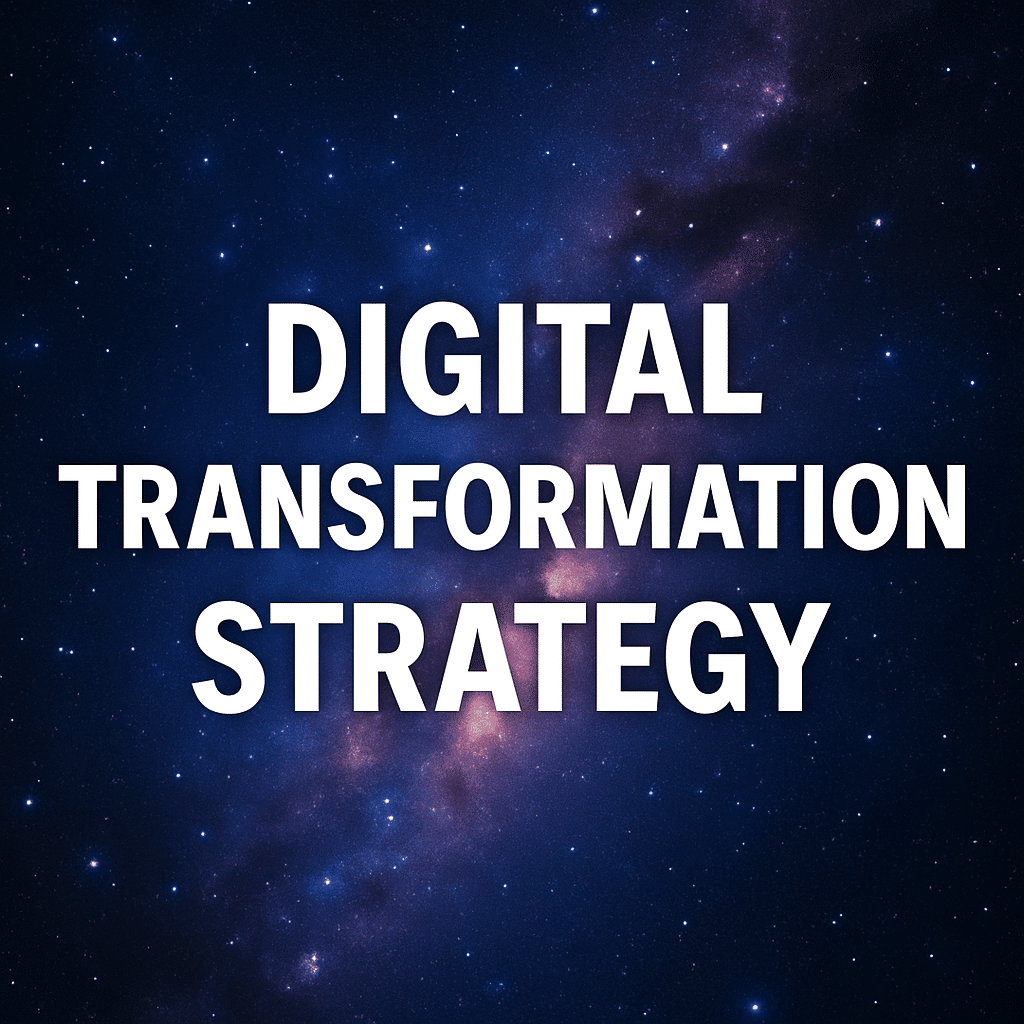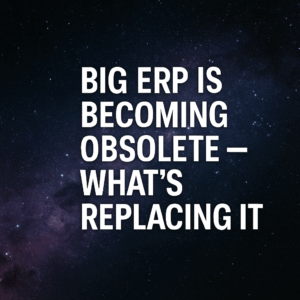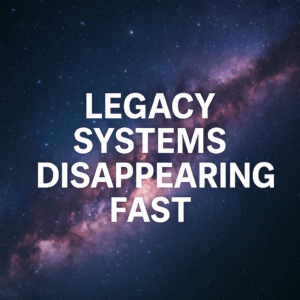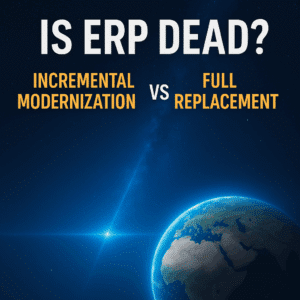Table of Contents
ToggleWhy ERP Software Alone Won’t Save Your Digital Transformation Strategy
Digital transformation is more than implementing ERP software. Companies often believe that investing in platforms like SAP S/4HANA, Oracle Fusion, or Microsoft Dynamics will automatically modernize operations and solve strategic challenges. But here’s the truth: ERP software alone won’t save you.
To succeed in today’s competitive landscape, organizations must first define their digital transformation strategy—and only then choose the right technologies, including AI solutions, to support it.
Strategy First. Technology Second.
ERP vendors often promote software as the solution to inefficiency or outdated processes. But in reality, business strategy must come before technology selection.
The most successful organizations start with:
- A clearly defined business model
- A deep understanding of their competitive differentiators
- A roadmap for how technology will enable—not define—that vision
ERP software can automate processes and improve visibility, but it will not fix a broken business model.
The Customization Trap: When ERP Becomes a Liability
One of the costliest ERP implementation mistakes is over-customizing software to match outdated or broken processes. This leads to:
- Cost overruns
- Delayed go-lives
- Long-term technical debt
- Low user adoption
Many companies make the mistake of using software customization to patch over foundational business problems. But this only introduces more complexity, makes upgrades harder, and increases total cost of ownership.
Customizing ERP software to fix strategy issues is a financial trap. Instead, fix the core business issues before investing in digital tools. Start with an honest business process assessment, streamline operations, and only then begin tailoring technology to fit your needs—not the other way around..
Why Now Is the Time to Reevaluate SAP and Vendor Lock-In
With SAP’s 2030 deadline for sunsetting ECC and R/3, many businesses feel forced into replatforming to S/4HANA. But this transition is more than an upgrade—it’s a complete reimplementation.
Consider These Risks Before Locking Into S/4HANA:
- Total cost of ownership over 5–10 years
- Long-term vendor dependency
- Disruption to existing IT teams and internal processes
This is a rare opportunity to step back and ask: Is now the right time to stay loyal to a single vendor, or is this a strategic moment to evaluate newer, more agile platforms?
Now is the perfect time to evaluate alternative ERP systems or consider a hybrid, best-of-breed approach that reduces risk and improves agility. Future-proofing your transformation means not putting all your chips in one vendor’s hands.
Embedded AI: Smart Innovation or Strategic Risk?
SAP’s latest move is to embed artificial intelligence (AI) into core ERP modules—finance, supply chain, and customer service. While this sounds like progress, it raises a critical question:
Are these AI tools solving real business problems or increasing vendor dependency?
Embedded AI Features SAP Is Releasing:
- Invoice matching automation
- Real-time demand forecasting
- Chatbots and sentiment analysis tools
While these features are helpful, you don’t need to rely on your ERP vendor for AI. Many organizations benefit from:
- Low-code/no-code AI platforms
- AI workflow engines
- Specialized third-party tools with better cost-benefit ratios
Using AI outside of your ERP system can help maintain agility, avoid vendor lock-in, and provide access to more advanced and customizable tools that evolve with your needs.
AI Infrastructure Slowdowns: What Amazon’s Caution Signals
Even hyperscalers like Amazon and Microsoft are slowing down their AI infrastructure expansion. While demand for AI remains strong, rising energy costs, tariffs, and geopolitical instability are causing delays in data center growth.
This shift is a wake-up call for business leaders: Don’t rely solely on AI hype. Focus on foundational readiness.
Build Your AI Strategy the Right Way:
- Clean and organize your enterprise data
- Define specific AI use cases
- Choose flexible, interoperable platforms
- Align AI adoption with long-term business goals
Final Takeaways for Business Leaders: Redefining Digital Transformation Success
It’s easy to get swept up in the excitement of digital tools, artificial intelligence, and modern ERP platforms. But if there’s one critical truth organizations must embrace, it’s this:
Digital transformation success isn’t driven by software — it’s driven by strategy.
Software is simply an enabler. Without a clear direction, aligned leadership, and a deep understanding of your business needs, even the most expensive ERP system or advanced AI tool will fall short. Companies that succeed in transformation aren’t the ones with the biggest tech stacks—they’re the ones with the strongest foundations.
✅ 1. Define Your Unique Business Model and Transformation Goals
Before evaluating platforms or vendors, take a step back and answer this: What makes your business different?
Transformation should amplify your strengths, not dilute them. Map out your business model, growth targets, and long-term goals. Get crystal clear on what success looks like for your company—and ensure that every technology decision supports that vision. This also helps you better assess what functions to automate, what to customize, and what to leave untouched.
Make sure your digital transformation strategy starts here. Without a defined vision, every step you take will be reactive rather than intentional.
✅ 2. Stop Using ERP Customization to Solve Strategic Misalignment
One of the most common (and costly) missteps is using software customization to compensate for internal dysfunction. When ERP becomes a bandage for unclear roles, broken processes, or misaligned priorities, the result is:
- Endless change orders
- Missed deadlines
- Bloated budgets
- Low ROI
Instead, fix your business issues before they hit your tech stack. Focus on process redesign, change management, and employee buy-in—then build technology around that foundation. This is a critical phase of any digital transformation strategy that often gets skipped.
✅ 3. Push Back Against Vendor Pressure — Explore Alternatives
SAP, Oracle, Microsoft—each wants your long-term commitment. And they’ll use deadlines, fear tactics, and FOMO to rush your decision. But vendor urgency should never override strategic evaluation.
Ask the hard questions:
- Does this platform align with our needs five years from now?
- Are we building flexibility or dependency?
- What’s the total cost of ownership—and exit?
It may still make sense to go with a vendor like SAP S/4HANA, but that decision should come from you, not their timeline. Conduct due diligence and compare total value—not just upfront capabilities. This evaluation step is an essential checkpoint within a sound digital transformation strategy.
✅ 4. Use AI to Empower People and Processes — Not Create New Risks
AI has massive potential, but it’s not a magic wand. Many embedded AI tools (especially those pushed by ERP vendors) are designed more for vendor loyalty than real operational lift.
Instead of defaulting to bundled AI, ask:
- Can we integrate third-party AI tools that better match our needs?
- How do we ensure data quality and ethical AI use?
- Can AI help automate mundane tasks to unlock time for innovation?
Done right, AI can enhance workflows and decision-making without compromising flexibility. Treat AI as a lever for scaling the digital transformation strategy—not a shortcut to avoid deeper planning.
✅ 5. Build a Tech-Agnostic, Strategy-Led Transformation Roadmap
The future of digital transformation isn’t about “owning the best software”—it’s about creating resilient, adaptable systems that evolve with your business.
Your roadmap should be:
- Tech-agnostic: not married to one platform or ecosystem
- Business-led: driven by your goals, not product features
- Incremental: designed to deliver value at every stage
- Flexible: able to evolve as the market and technologies shift
By focusing on these pillars, you reduce risk, increase speed to value, and retain the freedom to adapt as your organization grows. This phase of the digital transformation strategy ensures long-term sustainability beyond implementation.
Need Help With Your Digital Transformation Strategy?
Third Stage Consulting is an independent, technology-agnostic consulting firm helping organizations around the world navigate digital transformation with clarity and confidence.
📩 Contact us today for a personalized roadmap.





